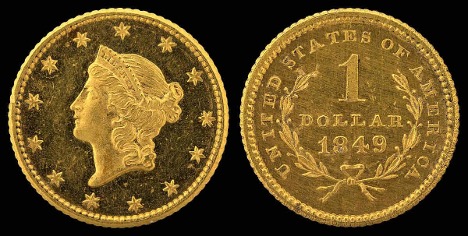Time flies. We’re at the 100th day of President Trump’s second term.
One piece of good news is that America’s southern border is as secure as it’s ever been in modern times. Trump and his people fixed that wide-open, Biden-era problem quite fast, by the novel approach of applying existing law. Amazing! Who knew?
Now the country doesn’t have to deal with 10-15,000 new arrivals every day, unknown, un-vetted people from all over the planet who just walk in and immediately become a burden on the country’s broken budget.
On the other side of the political ledger, the economy is weakening, something we predicted in articles going back deep into 2024. And many federal judges have decided to wage lawfare on the 47th President, itching for a so-called “Constitutional crisis” that they will blame on Trump.
Overseas, international tensions remain high; Eastern Europe, Middle East and East Asia all speak for themselves. There’s nothing easy about any of those problems, and they cost money that the country can ill-afford just now.
All this, and last week the price of gold hit $3,500 per ounce before receding to the low-$3,300s price range. So gold is moving; but will it head upwards or is a pullback in the cards?
In this note, let’s discuss Trump and gold, but mostly gold.
From $1,200 to $3,500
On Jan. 20, when Donald Trump took his oath of office, the gold price was $2,725 per ounce. Now, after 100 days it’s about $3,325, an upward move of 22%. Correlation is not causation, as I learned many years ago in statistics class, but Trump still owns some of that move.
While we’re looking at Trump, let’s time-travel a decade ago to mid-2015 when the New York businessman dove into national politics and announced his run for the presidency. Back then, the price of gold was just shy of $1,200 per ounce. And over the past 10 years gold has moved up by about 177%. This chart will help you visualize:
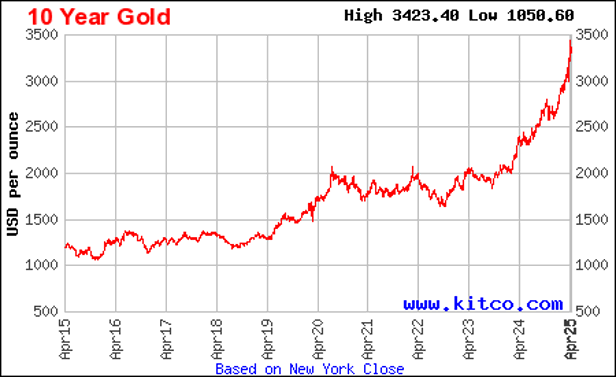
Ten years of gold prices. Courtesy Kitco News.
Of course, Trump alone doesn’t move the price of gold. Sure, he was president for four years, 2017-21. Then, he was not president for four years; and in fact, from 2021-25 he spent much of his time as a professional defendant in multiple court cases. Now he’s back in the Oval Office at the three-plus month marker. But c’mon, man… all sorts of things move gold prices.
In this regard, it’s more accurate to say that the price of gold reflects global-scale perceptions of the inherent (and declining) value and utility of U.S. dollars; and yes, Trump definitely sways perceptions.
That is, if world markets perceive that the U.S. economy is strong and things look good for the future of America, then gold prices tend to moderate; they find a range. But if markets sense weakness in the U.S. or its economic future, then the price of gold rises.
Again, Trump plays a big role in all of this, but he’s only one factor among many.
Money and Purchasing Power
To help understand the moves in gold prices, let’s do a quick (I promise) history lesson. We’ll start in 1914, with a standard $20 coin called a “St. Gaudens,” named after the designer.
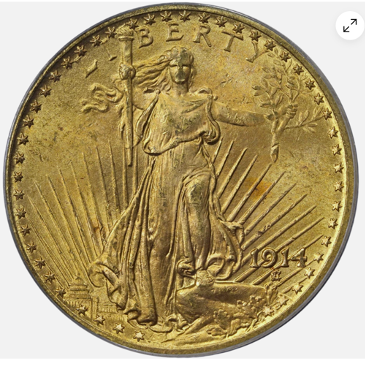
U.S. 1914 St. Gaudens gold coin, $20 value. eBay screen grab.
This coin has a bit less than one ounce of gold in it (30.093 grams to be exact), along with a small measure of copper to harden the alloy. When it was minted 111 years ago, this item was worth a face value of $20, and the gold was also worth $20. In other words, and to channel the ghost of long-deceased tycoon J.P. Morgan, “gold was money” back then, and twenty dollars bought an ounce of gold.
If you’re wondering why I chose 1914, it’s because that was the first year of the U.S. Federal Reserve, meaning America’s central bank. President Wilson signed the Federal Reserve Act on Dec. 23, 1913, literally in the dead of night, during a holiday period in a nearly empty Washington, D.C. which tells you much about how the Fed came into being.
Then as 1914 unfolded, and in one of the Fed’s first official acts, it issued so-called “notes,” among which some were valued at $20, like this beauty:
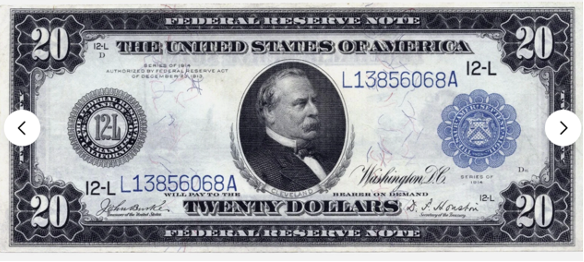
1914 Federal Reserve $20 “Note.” eBay screen grab.
As you can see (if your eyes are that good), the note specifically states: “The United States of America will pay to the bearer on demand Twenty Dollars.” Meaning yes, you could take this to a bank and exchange the paper for a gold coin.
Today, you might be forgiven to think that the above-pictured note itself is itself $20. But no, that’s not the case; that 111-year-old item is definitely not $20, it’s just a promise. Again, that’s because long ago, “twenty dollars” meant an ounce of gold, ideally stamped into the shape of a coin.
To nail the point, in 1914 gold was real money; paper notes were just promises, even those issued by the Fed. That’s even if, as in the case above, the U.S. government was the promisor who guaranteed payment in gold.
Which brings us back to last week’s gold price rise, up above the $3,500 line, and then the subsequent pullback to the current level around $3,325.
Steady Debasement and Federal Troughs
Do the math… At $3,325, you now need over 166 Federal Reserve $20 bills – like those that you get from the local ATM machine – to buy an ounce of gold; and that’s just the gold, not allowing for any numismatic value to an old, rare coin.
Look at it this way; over the past 111 years, the dollar has shrunk in purchasing power and its ability to preserve wealth by a factor of 166. Or stated in another way, a penny from that 1914 era is now worth $1.66.
The value-loss of the past century had nearly nothing to do with President Trump. Indeed, for that decline in the dollar’s value we can thank many Presidents: Wilson, Harding, Coolidge, Hoover, Roosevelt (Franklin), Truman, Eisenhower, Kennedy, Johnson, Nixon, Ford, Carter, Reagan, Bush (H.W.), Clinton, Bush (W.), Obama, Trump (first term), Biden… and now Trump 2.0 at his 100 day mark.
Generation after generation, president after president, the U.S. government routinely engaged in deficit spending. This is certainly the case since 1971, after President Nixon essentially tore up the World War II-era Bretton Woods agreement which kept the dollar tied to the value of gold. Since then, federal spending, deficits and the national debt have mushroomed.
Now the nation owes unpayable levels of national debt, around $37 trillion. That, plus something approaching $2 trillion in interest due every year, a sum which cleans out most of the cash in the Treasury’s accounts. And it’s axiomatic that the annual federal deficit is paid with borrowed funds, including what gets paid as interest on past debt. All in all, our national accounting scheme is a highway to ruin.
To compound the matter, current American culture doesn’t seem to know what to do with itself absent massive federal spending, particularly deficit spending which is sewn into the social fabric of the country.
For many decades, Congress has been institutionally incapable of cutting the budget. Politically, there are few accounting priorities in Washington; they fund just about everything. And we almost never program terminations except for a few of the most grievous military procurement boondoggles.
More recently – the past 100 days – we’ve witnessed the nation’s collective inability to deal with spending cuts. Consider the apoplectic, psychotic reactions in many quarters to federal spending freezes and shutdowns. Or to state it another way, we hear the sound of rice bowls being broken.
For example, we have Trump’s Department of Government Efficiency (DOGE), which in just three months has torn through one federal agency after another. DOGE cut budgets, laid off staff, closed offices and more. And predictably, the mainstream media went nuts while people across the Republic went to court, seeking a friendly federal judge to issue an order blocking the president from not spending money that, at root, the country doesn’t have.
Did Trump cut too many things, too much, too fast? Hey, argue it any way you want because it depends on what’s in your rice bowl. Does America need most of what, say, U.S. Agency for International Development (USAID) was doing? Does the country need the Department of Education? And so on; there’s a long list and no need to detail it here.
Then again, at an even higher plane, can Trump ever begin to “cut” enough spending to save the financially foundering ship of state? So far, Trump has eliminated perhaps $200 billion in federal expenditures, but the number ought to be ten times that size. Good luck, right?
The problem is that for better or worse, every federal dollar is someone’s income. So when federal spending declines, it’s money no longer in someone else’s pocket. It’s no wonder that house sales are down, airlines are selling fewer tickets, hotels are booking fewer rooms, auto dealers are selling fewer cars, and so on.
Whether Trump is President or not, the fact is that the country is painted into a fiscal and monetary corner. There’s too much debt and interest, and not enough cash to pay for it absent inflating the currency. Sure, Captain Trump has rearranged some deck chairs on the Titanic, but the ship is still sinking based on a century of federal policy and misallocation of the country’s resources. Face it, there’s no nice, clean, easy, pretty way to fix what’s broken.
Gold as Money, Redux
Now, here’s one final point, which is that gold is slowly remonetizing. The world is moving towards a revised gold standard, and away from American petrodollars of the past half century. Yes, it’s happening under Trump but this trend was happening in any event, Trump or not.
Start with the gold price, in this cast the 5-year chart which makes things easier to see:
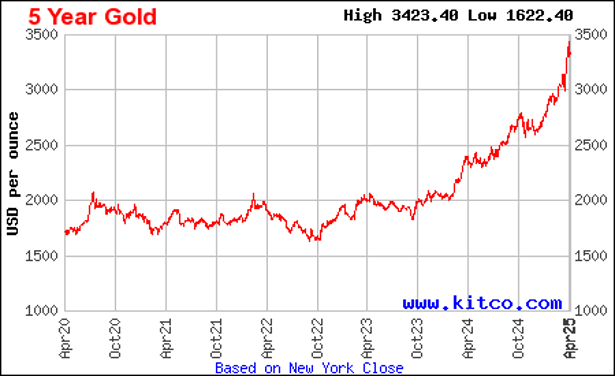
Five years of gold prices. Courtesy Kitco News.
Notice the upward trend in gold prices that began in mid-2022 during the Biden administration; in fact, it occurred not long after the U.S. government seized and froze massive amounts of Russian sovereign wealth, at the time locked up in Treasury bonds. That is, the U.S. weaponized its currency, its banking system, and even its underlying basis of government finance.
In response, the world reacted as one might imagine; central banks bought gold, the price of which has moved from $1,750 to the recent $3,500 level, a double in under three years. And don’t be misled, it was central banks that bought large blocks of metal. Gold’s big move was not due to retail buyers down at the coin shops, nor hedge funds, banks, family offices, etc.
For three years, central banks unloaded dollars and derisked their long-term holdings. This reflects their collectively negative future perceptions of the U.S., its economy and strength. Frankly, it doesn’t matter that Trump is now President. Central banks were buying gold in 2022 when Trump was battling state and federal prosecutors who wanted to toss him into jail.
That is, Trump had nothing to do with what kicked off the 2022 upward move in gold prices, a rising tide on which we’re now floating. Yes, Trump’s recent on-again, off-again tariff policies have created confusion. His budget and spending priorities are still in formation. But that’s not what elevated gold to $3,500 last week.
Gold didn’t spike up because the metal is somehow shinier or denser, or because the future of the U.S. economy looks brilliant. Gold moved up along trend lines that are three years in the making.
The bottom line is that many people who control vast amounts of wealth realize that America’s fiscal and monetary house is totally dysfunctional and unsustainable. The U.S. budget is broken, the national debt is unpayable, the interest will kill the Treasury account.
Will gold keep going up? Yes, of course, and it’s hard to see why not. Own gold or you’ll live to regret it.
Sure, expect pullbacks along the way, certainly during market sell-downs and especially if/when there’s a crash. We may again see gold under $3,000, but not for long. Buy those dips and hold the metal when you can take possession.
To sum it up, President Trump has had his first 100 days, and now he’ll have another, and another. We’ll see how things unfold with tariffs, trade, taxes, reinvestment in America and all the other campaign promises.
But some things are bigger than one president and his term in office. The U.S is over a century getting into the current mess, and we’ll be many decades digging out. You had better own some gold as it all plays out.
Thank you for subscribing and reading.

